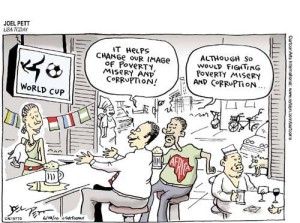Could jersey prices really be the issue? Or is there more at play?
Controversy arose earlier this week on Monday when England revealed their jerseys for the upcoming World Cup. The jerseys, it turned out, cost a surprising 90 pounds (150 US Dollars) and caused a frenzy from not just the English media, but for the British Prime Minister David Cameron as well.
Many have called the jerseys (which Nike manufactured) a rip off. Citizens of England are calling for boycotts and sports minister Helen Grant has asked Nike to lower the prices of the jerseys.
Cameron himself pointed out the stigma that it will have on the parents. “Parents are under enormous pressure to buy the latest kit and we shouldn’t be taken advantage of,” he said in a Reuters article.
But amidst all the controversy and the media speculation, a few things stick out more than others.
For one, Nike is not doing anything new when it comes to the skyrocketing prices of jerseys. Soccer has grown popular with each passing year and more importantly, it is slowly becoming popular in the United States. The big demand of jerseys from fans all over the world calls for higher prices for the merchandise and with more call for the merchandise comes more demand for better quality.
Both elements go hand in hand. It is the same dilemma that other companies such as Adidas are also facing and competition just amps up the prices even more. That is how supply and demand works for items within the marketplace.
But it is not the prices of the jerseys that is the important subject.
Another important aspect of this controversy is Nike and England’s Football Association’s reasoning for the high prices. According to a comment made by both the FA and Nike, the jerseys have climacool ventilation holes designed in them to better accommodate the weather the players will face during their time in Brazil.
Once again, this becomes a discussion about FIFA’s choices when it comes to host nations. Joseph Blatter and company always make it a point to say that the choices made when it comes to host nations focuses on countries that deserve to have soccer impact their citizens.
“This is the development of football and don’t speak about money. This has nothing to do with money, as it had nothing to do with money here in Africa. It has to do with the development of the game,” he said back in 2010 during the host bids for the 2018 and 2022 World Cups in Qatar and Russia.
He went on to defend this by mentioning the great impact the World Cup had on South Africa earlier in 2010. About $100 million legacy fund went to South Africa and $20 million of that had already been used to build a new South African Football Association headquarters and stated the rest would go to “social and community projects.”
He failed to mention the $3.5 billion FIFA made that year as well.
Brazil’s weather condition is not the only thing players will have to look forward to when they arrive to host nation later this year.
Political and social conflicts are still taking place–much of it involving the unequal disparity of money within the society.
FIFA’s next two host nations, Russia and Qatar, are also facing their own crises at the moment. Russia with its very public situation about the Ukraine and Qatar with both its strict drinking and anti-homosexual laws has many people questioning the role of money when it comes to “the beautiful game.”
Even more worrisome is the fact that two migrant workers died in Qatar on the building sites of the 2022 stadiums there (the same situation that is going on in Brazil). The “little man” in society continues talked about but not focused on in these conversations.
Which brings us back to England’s World Cup jerseys. If so much speculation is about Nike’s jerseys because of the climacool adjustments made to it for Brazil, what about the World Cup being moved to the Winter because Qatar’s summers are known to rise as high as 104 degrees Fahrenheit?
How expensive will those jerseys be? Does that really matter? Or is “the beautiful game” just getting very ugly?

Leave a Reply
You must be logged in to post a comment.